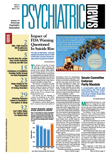The Food and Drug Administration (FDA) has approved paliperidone in an extended-release (ER) formulation for the treatment of schizophrenia. Paliperidone is the principal active metabolite of risperidone, which is already marketed for treatment of this condition but is not available in an extended-release formulation.
Paliperidone ER is manufactured by Alza, using the company's patented OROS extended-release technology. It is being marketed under the brand name Invega by Janssen, which also markets risperidone. Both companies are part of Johnson and Johnson.
Paliperidone ER was tested in three six-week, placebo-controlled trials in North America, Europe, and Asia, involving 1,665 adult patients, the FDA reported. Results from a separate, longer relapse-prevention study were reported in the February Journal of Psychopharmacology.
Dosages ranging from 3 mg to 15 mg a day were found to relieve schizophrenia symptoms more successfully than placebo. The recommended dose range of paliperidone ER is between 3 mg and 12 mg a day.
Paliperidone ER can be administered once a day without causing the plasma-level peaks and troughs associated with other drugs in its class, according to George Simpson, M.D., director of the outpatient clinic at Keck School of Medicine at the University of Southern California.
Simpson, who receives grant support from Janssen, is the author of an article on paliperidone ER that appeared in the November 26, 2006, Current Psychiatary.
Because the liver metabolizes paliperidone to a lesser extent than it does risperidone, it is thought to be less likely to trigger drug-to-drug interactions compared with other antipsychotics, Simpson reported.
He referred in his Current Psychiatry article to one of the three six-week studies on which the FDA based its approval of paliperidone ER involving 444 patients who had acute exacerbations in their schizophrenia symptoms and Positive and Negative Syndrome Scale (PANSS) scores between 70 and 120. The patients received 6 mg or 12 mg a day of paliperidone ER or 10 mg of olanzapine a day or placebo. Olanzapine was included only for assay sensitivity, not as an active comparison drug.
“Mean baseline total and negative symptom PANSS scores improved twice as much for the paliperidone ER and olanzapine groups compared with placebo. Personal and Social Performance (PSP) scale scores also improved significantly among patients receiving 6 mg of paliperidone ER a day. The PSP scale gauges function, ability to perform socially useful activities such as self-care and work, and disturbing and aggressive behavior,” Simpson wrote.
Simpson also cited the results of a longer relapse-prevention study led by Michelle Kramer, M.D., who works for Johnson and Johnson. That study, in which Simpson participated, was designed to measure paliperidone ER's ability to delay or thwart relapse.
Patients who had taken paliperidone ER for 14 weeks were randomized to continue on the drug or take a placebo; the percentage of subjects who relapsed and the time to relapse were measured. Of 205 subjects, 22 percent who took paliperidone ER relapsed compared with 52 percent on placebo. Twenty-five percent of patients on placebo experienced a relapse by 23 days, compared with 68 days for those on paliperidone ER.
Commonly reported side effects in the clinical trials included restlessness, extrapyramidal symptoms, rapid heart beat, and sleepiness. Mean prolactin levels in Kramer's study were four times higher in men who took paliperidone ER than in men who took placebo (40 ng/ml vs. 10 ng/ml) and five times as high among women (100 ng/ml vs. 20 ng/ml) who took paliperidone ER at any dosage.
The incidence of tachycardia was higher (14 percent) among patients in the paliperidone ER and olanzapine groups than in the control group (0 percent).
According to the drug's labeling, paliperidone causes a modest increase in the corrected QT (QTc) interval. Thus, the use of paliperidone should be avoided in combination with other drugs that are known to prolong QTc.
Simpson noted that 6 mg a day is no more likely to cause extrapyramidal symptoms or other adverse events than a daily dosage of 10 mg of olanzapine or placebo. “This finding suggests that 6 mg per day might be a suitable starting dosage for most patients,” he wrote.
Second-generation antipsychotics have been linked to an increased mortality rate in patients with dementia and should not be used to treat dementia-related psychosis, according to the black-box warning on the product's label.
“Paliperidone, while not a major break-through, does represent an incremental advance in medications to treat schizophrenia,” Jeffrey Lieberman, M.D., chair of the Department of Psychiatry at Columbia University and director of the New York State Psychiatric Institute, told Psychiatric News. “Its long duration of action, which permits once-a-day dosing, and its potential formulation in a long-acting injectable form [which has not yet been approved by the FDA] are likely to increase compliance among patients who have trouble remembering to take their medications.”
Lieberman is also chair of APA's Council on Research. He has grant support from Janssen, unrelated to paliperidone ER.
Information on the FDA's approval of paliperidone ER is posted at<www.fda.gov/bbs/topics/NEWS/2006/NEW01534.html>.▪
